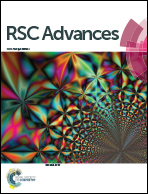A novel strategy to enhance ultraviolet light driven photocatalysis from graphene quantum dots infilled TiO2 nanotube arrays†
Abstract
Herein, a novel strategy has been proposed to fabricate graphene quantum dots (GQDs) infilled titanium dioxide (TiO2) nanotube arrays (NTAs) hybrid structure for dye degradation of methylene blue (MB) under UV light (365 nm) irradiation. GQDs are infilled inside the TiO2 NTAs (via anodic oxidation of a Ti sheet) through an impregnation method. Moreover, the morphology of the TiO2 NTAs is well maintained after filling the GQDs inside, which is favorable for mass transfer. The peak intensity of photoluminescence (PL) spectra of the GQDs infilled TiO2 NTAs catalyst is lower than that of annealed TiO2 NTAs and a strong violet UV emission is obtained at 387 nm upon 252 nm deep UV excitation. The photocatalytic activities of the TiO2 NTAs are evaluated in terms of the efficiencies of photo-decomposition and adsorption of MB in aqueous solution under UV light irradiation, after the impregnation of GQDs inside the TiO2 NTAs. The highly-efficient photocatalytic activity is attributed to the broad absorption in the visible wavelength region, large photo-induced charge separation through the transfer of photo-generated electrons from the TiO2 NTAs to GQDs, as well as the strong adsorption capacity of the GQDs to MB molecules. Thus, the GQDs infilled TiO2 NTAs could be widely used as a photocatalyst for treating organic contaminants in the field of environmental protection.


 Please wait while we load your content...
Please wait while we load your content...